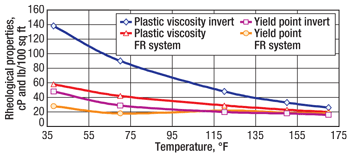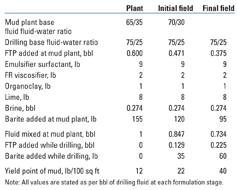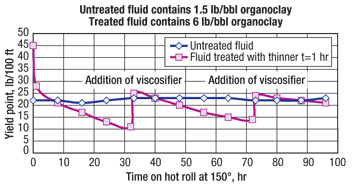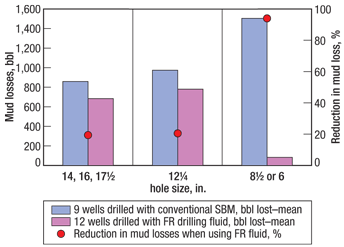A new, simplified drilling fluid system with nearly temperature-independent rheological properties dramatically reduced lost circulation in wells drilled in the South China Sea.
Robert Schlemmer, Scomi Oiltools, Kuala Lumpur, Malaysia;
and Jonathan Sheldon, Sarawak Shell, Miri, Malaysia
Flat-rheology drilling fluid, in routine use in the Gulf of Mexico since 2004, was designed to prevent loss of circulation to induced fractures resulting from the elevated equivalent circulating density (ECD) that is typical in cold deepwater drilling. The drilling fluid functions differently from lost-circulation material (LCM). The term flat rheology, considered misleading by some engineers, can describe two distinct rheological concepts. An early definition of flat rheology (FR) describes a rheological measurement at a 6-rpm test speed as being as close as possible to the 100-rpm reading or the yield point measured using an industry-standard couette viscometer, measured at a single temperature of 50°C. This “flatness” of rheology is purported to reduce sag in high-angle holes and improve cuttings-bed pickup. A more current definition of flat rheology describes comparatively unchanging plastic viscosity, yield point, 6-rpm reading and 3-rpm reading at 4°C, 50°C and 75°C, as measured with a standard couette viscometer. Drilling fluid designed to conform to this latter definition of FR was developed for implementation in a deepwater field offshore Sabah, Malaysia. The system’s first use began in December 2007 and continues to the present.
Field implementation was delayed by a year-long postponement of the deepwater project through 2007, which allowed laboratory time for improved understanding and refinement of the technology. For example, study of control of differential solubility of the unique rheology modifier contributed to a fluid that is flatter, is usable at higher temperatures, and requires less or no organophylic clay. The extended testing produced a simpler system, essentially eliminating three additives, and resulted in the proprietary FR mud system’s outperformance of two competitive muds in terms of economics, robustness and ease of use. Supplemental additives for rheological boost during initial mix and transport are no longer recommended as general inventory items. A special thinner is no longer needed or recommended, because loss of rheological control is unlikely.
The FR system is an “ugly duckling” mud with a personality unlike conventional non-aqueous fluids (NAFs) during mix, transport and displacement. The FR fluid is not fully formed in the mix-cup or mud plant as are conventional NAFs. Only after the FR mud has been circulated and used for drilling are its beneficial characteristics fully measurable, these being good filtration control, excellent rheological properties, and a general robustness, Fig. 1.
 |
|
Fig. 1. Comparison of the rheological profiles of an FR mud system versus a conventional invert-emulsion mud system.
|
|
BACKGROUND
Drilling in cold water results in a three- to fourfold increase in viscosity of conventional invert-emulsion drilling fluids when the mud temperature is reduced to that of the cold deepwater environment. A viscosity increase is most troublesome when circulating bottoms-up after the mud system has remained static for a period of time.
A viscosity increase will also be measured when the riser is “boosted” by an auxiliary pump. Mud is pumped through a separate “boost line” to the subsea BOP to increase the volume of flow in the large-diameter riser pipe extending from the seabed up to the rig. The continuously recirculating “boosted” mud causes a noticeable temperature drop in the mud pits and mud returned from the well. High viscosity of returned mud generally necessitates the replacement of fine shaker screens by less fine screens to avoid mud losses.
In the well itself, a cold drilling fluid generally has increased resistance to flow. If resistance to flow occurs when the mud density window is small (i.e., the window between the fracture gradient and the pore pressure), ballooning losses to induced fractures are likely. Typical invert-emulsion drilling fluids become viscous and do not flow easily at seabed temperatures; the increase in resistance to flow due to frictional losses increases the fluid column hydraulic pressure when circulating. Any increase in column hydraulic pressure can overcome the wellbore horizontal stress and exceed the fracture gradient.1 Effects can include costly loss of drilling fluid, severe reservoir damage and loss of wellbore integrity.
Conventional invert-emulsion muds used in cold-water scenarios can also induce fractures when the mud hydraulic pressure approaches the minimum horizontal rock stress (fracture gradient). Fracture induction and propagation in shale is difficult to control with LCM and may be addressed more fundamentally by introduction of drilling fluid additives that:
• Maintain a uniform maximum limit of rheological properties over a broad temperature range extending from near zero to bottomhole temperatures approaching 250°F
• Maximize hole cleaning and minimize sag by providing a controlled minimum limit of rheological properties over that same range of temperatures
• Make the fluid system easy to mix and transport
• Improve fluid stability and robustness when drilling
• Prevent increased ECD under extreme deepwater drilling conditions.
Flat-rheology drilling fluid provides a robust system that is unusually solids tolerant. The surfactant package and special polymer support and actually improve rheological properties as drilled solids increase. FR systems are immune to, and can be improved by, cement contamination; remain controllable and stable with seawater intrusion; and experience minimal disposal losses due to contaminants. Less dilution is required, and the system can be reused across several wells.
The well-mannered, consistent rheological properties of an FR fluid contrast with the high viscosity and gellation of a conventional invert-emulsion mud observed after a trip or when using a booster pump. Tripping times are faster compared with a conventional mud, and do not require staged circulations to overcome cold and gellation. Also, this new fluid design does not interfere with the use of fine shaker screens; mud is much less likely to be lost over the shakers when it becomes cold. Oil on cuttings is also efficiently removed because of the improved rheological profile, making it easier to comply with offshore regulations.
Testing has confirmed that FR mud systems can be formulated from a variety of base fluids including olefins, hydro-treated mineral oils and Fischer-Tropsch paraffins (FTPs), as well as less purified mineral oils. The base oil can be selected for the particular environment of the application.
DEVELOPMENT AND PAST APPLICATIONS
Two previous papers cover the justification for use and developmental history of FR drilling fluid for the deepwater Sabah application.2,3 Other papers have detailed the advantages of the category of FR system discussed in this article, as used on deepwater wells in the Gulf of Mexico. A 2004 paper based on Shell’s field experience in the GOM establishes expectations and benefits of FR fluid system use.4 A 2007 publication reported BP field results of another flat-rheology system applying the same core technology, including key high-temperature components, developed for the Sabah application.5 Compared with previously developed olefin-based FR fluid, this new fluid offered a more robust rheological modifier and a simplified recipe that increased temperature stability by at least 50°F. The data collected in the Shell and BP papers included drilling performance, ECD, downhole pressure and lost-circulation data.
All published field trials have confirmed the excellent laboratory test results. More importantly, initial field trials have been followed by routine and ongoing usage. The flat-rheology fluids have consistently reduced losses of expensive synthetic base mud, improved cuttings clearance from wells and demonstrated no barite sag. Circulating losses to induced fractures had been a significant problem on previous wells, and FR fluids have provided a step-change improvement for controlling a very expensive problem.
Ongoing development details. A non-aqueous FR drilling fluid was designed in Malaysia using primarily local products. A workable formulation was quickly achieved and was tested by the operator against design specifications in its Houston, Texas, laboratory.
All original development work had been performed assuming maximum sustained temperatures of 190–200°F as defined and specified by the operator. It was learned that temperatures up to 220°F would be experienced, but only after a short, steep temperature ramp. It was also learned that the mud would not reach that sustained temperature until TD was achieved and circulation halted. Upon commencement of drilling with FR fluid, a 130°F formulation was determined to be more appropriate. The lower-temperature formulation requires significantly less emulsifier to achieve desired properties. A more economical formulation was specified for use before penetration of the higher-temperature reservoir rock, and this practice was put to use in the field. An improved special polymer additive to the fluid was tested for sustained stability when drilling at bottomhole temperatures in excess of 300°F.
Laboratory modeling revealed that extended low temperature aging (as would be experienced in a liquid mud plant and during storage and transport) produced a much more stable fluid for later application in a well. An extended lower-temperature, low-shear mixing regime and low-temperature hot roll, which more closely models actual mud plant mix and mud transport, are now included in the system procedure manual. The change in mix procedure reflects an effort to increase the potential for more economical formulations.
Temperature-labile fatty acid emulsifier/viscosifiers were originally proposed for supplementing mud plant formulation to prevent barite settling. The longer-term effect of fatty acid emulsifier/viscosifiers was studied in detail. It was discovered that fatty acid-based viscosifiers often used to boost the viscosity of mud plant-prepared FR and conventional mud systems causes long-term damage to the special associative polymer in FR muds. The associative polymer is key to the flat rheological performance of olefin- and paraffin-based FR systems used in the US and Malaysia. As simple fatty acid emulsifiers degrade with temperature, they begin to act as thinners and can ultimately double the required concentration of polymeric viscosifier and organophyllic clay with loss of flatness of rheological properties. The use of fatty acid viscosifier materials is no longer recommended for general use.
Use of conventional polymeric rheological emulsifiers was also proposed as a supplement to reduce sag of mud plant mixes. However, addition of secondary rheological modifiers and/or extra organophyllic clay reduced the “flatness” of the rheological profile. As drilled solids increase after drilling begins, the plastic viscosity and yield point can exceed specified values across the temperature range, most significantly at low temperature.
A new mud plant mix technique was established that could substitute for the special viscosifiers that were often used but ultimately wasted. A modest adjustment in the mud plant formulation was developed and applied on the first offshore well. All of the final-formulation drilling fluid components are added at the mud plant with the exception of two, Table 1. A portion of the base fluid is withheld to reduce the spent-wash (SW) ratio (e.g., from 75/25 to 65/35) or, as pilot tested, to achieve a yield point of about 40–45 lb/100 sq ft.
| TABLE 1. Mud plant and field formulations of FR system |
 |
Barite addition is reduced just enough to achieve the correct final density. After transport of the mud plant mix to the wellsite and after drilling for a few hours, the SW ratio is gradually adjusted upward to the programed 75/25 or 80/20 and barite is added to maintain the mud density. This simple procedure has worked without complication. No additional materials were required; a yield point of 32–40 lb/100 sq ft was achieved. No barite sag was experienced at the mud plant or on the boat during transport.
Use of this concentrate is the simplest, least expensive and least damaging method of managing an FR mud system in the mud plant. The final, desired FR profile will only fully develop after incorporation of drilled solids during the first day of drilling. The FR mud system is fundamentally based upon a structured matrix of polymer, organoclay and emulsifier interactions. Subsequent movement of used FR mud does not require any special handling techniques.
An FR mud may be described as a flocculated invert-emulsion fluid. Before incorporation of drilled solids enhances the overall stability of the fluid system, some top oil separation (TOS) may occur. This separation is reduced by continuous agitation and will be well-controlled after circulation through the bit with inclusion of drilled solids. Use of primary emulsifiers, stearic acid, dimer/trimer acids and additional organoclay can all eliminate TOS at the mud plant, but to the severe rheological detriment of the fully formulated mud at the rig.
A proprietary thinner was initially specified for the FR system to compensate for possible organophyllic clay over-treatment by inexperienced mud engineers. The most vigorous thinner is effective with application of less than 0.25 lb/bbl, matching the performance of chemically equivalent materials used in competing systems. It was found that use of such a chemical causes sustained damage to an FR system that is time consuming and expensive to correct. As shown in Fig. 2, addition of 0.5 lb/gal of the thinner caused ongoing loss of yield point and 6-rpm values for more than four days. Dedicated thinners have been eliminated from the system procedure manual as a standard product. These thinners must only be used in the very unlikely event that rheological properties get out of control due to mistaken and extreme addition of organophyllic clay. The primary viscosifier of the FR system is not organophyllic clay, and over-treatment is much less likely than in conventional invert-emulsion muds, which usually incorporate 6–10 lb/bbl of organoclay.
 |
|
Fig. 2. Effect of treatment with thinner on the FR mud system.
|
|
A critical component that the developers of the original system neglected was lime. The fully reacted emulsifiers and/or wetting agents typically used in these FR mud systems do not require the divalent cation of calcium to form an emulsifying soap. Reduced concentration of lime, if any at all, was used in early formulations. In late 2006, original work performed by Khor Siak Foo, formerly with Scomi Oiltools, demonstrated how a “lime effect” is required to attain temperature stability and optimal rheological properties of the FR mud system. Khor’s work defined how alkalinity of the drilling fluid affects the solubility and efficiency of the associative polymer and actually drives partitioning of the polymer between phases with change in temperature. As temperature increases, an increased pH of the water phase increases partition of the polymeric viscosifier into the non-aqueous phase, improving 6-rpm through 300-rpm rheological measurements. Several pH buffers were tested, but none offered significant improvement to system rheological properties compared with lime.
Rheological properties, hole cleaning and ROP. A fundamental benefit of the balanced, flat rheological profile of the FR system is excellent hole cleaning across the full range of temperatures experienced in deepwater wells. Efficient cuttings removal can be achieved with the plastic viscosity limited to about 50 cP, about one-half to one-third the plastic viscosity that would be experienced with a conventional invert-emulsion mud. Conventional muds often sacrifice hole cleaning to reduce the ECD elevation caused by severe thickening of the mud due to cold-temperature viscosity and gellation. Conventional muds are therefore often run with less viscosity. Unfortunately, this can lead to cuttings accumulation in the fluid column and increased ECD due to actual density increase of the solids-laden drilling fluid. Alternatively, penetration rate must be slowed and controlled to prevent overloading the annulus with cuttings. The incidence of barite sag is also increased.
The goal in every drilling interval is to manage flowrates and fluid characteristics so that the mass of cuttings removed by the shakers and other surface equipment matches the mass of the cuttings generated at the bit. However, accelerated penetration rates always lead to some degree of increase in the concentration of cuttings load in the annulus, all other factors remaining constant. This increase in cuttings load causes an increase in mud density and ECD and can lead to mud losses to induced fractures if not controlled by either adjustment of rate of penetration or adjustment of rheological properties to maximize hole cleaning.
Aggressive rates of penetration can lead to actual accumulation of cuttings at rheological transition regions or in washouts in the wellbore. During connections, the cuttings will fall, collecting around the bottomhole assembly or drillstring tool joints. At the very least, pressure spikes will occur when circulation is restarted. Fractures can be initiated or extended by those pressure spikes. Worst-case results of the collection of cuttings that are not uniformly removed are packoff of the hole, stuck pipe, and total and often intractable induced losses.
Improved flow properties thus reduce the ECD and subsequent losses to induced fractures in three ways: 1) Yield point is easily maintained, contributing to efficient cuttings clearance. 2) Reduced pressure drop in drill pipe and increased pump output can also improve hole cleaning and reduce the cuttings load. 3) A flat viscosity profile ensures the lowest possible frictional losses in the annulus and minimum hydraulic contribution to ECD.
By reducing the hydraulic contribution and cuttings load contribution to ECD, the FR system delivers higher penetration—as much as 30 ft/hr higher than a conventional invert-emulsion mud prepared from the same synthetic base fluid. The drilling rate can be increased without necessarily increasing the ECD beyond designated limits. In the initial trial of an FR system, the 17½-in. section was drilled with penetration rates as high as 150 ft/hr with no mud losses.
SABAH APPLICATION
After three years of routine use in the GOM, FR drilling fluids were applied to a deepwater field offshore Sabah. Water depth exceeded 1,000 m, ranging from 2,219 ft to 4,646 ft. In the first 12 wells of a 15-well project, the FR system, formulated with base fluids other than olefin or ester, has proven predictable, reusable and economical. The mud performed well during logging and running of casing and liners, which have been free of incident, despite bottomhole temperatures higher than the degradation temperature of the primary polymeric viscosifier.
FR drilling fluids were specified primarily because losses on the conventionally drilled wells were expected to increase on the higher-angle, extended wells in the latter part of the drilling program. These wells would require higher mud densities to maintain hole stability. ECD would also increase with the increase in measured depth. The projected field fracture gradient was unchanged and the mud density window was narrowing, as wells reached farther into the reservoir in 2008 and 2009.
The drilling results for offshore Sabah wells remain largely confidential, so data is not available to provide comparison of wells drilled from 2003 through 2007 using conventional non-aqueous fluids with the 2007–2009 well series drilled using the FR system. However, lost-circulation data was made available for nine of the Sabah wells drilled with conventional synthetic-based mud for comparison with mud losses in the first 12 wells drilled with FR fluid, Fig. 3. This data shows that use of the FR fluid system significantly reduced mud losses across a range of hole sizes, with a reduction of over 90% in mud loss for 8½-in. and 6-in. holes. Two wells where the fracture-gradient/pore-pressure window was very small also used “stress caging”-sized LCM. The wells experienced no losses, and the mud has been reused, after centrifuging, on several subsequent wells.
 |
|
Fig. 3. Average mud losses for conventional versus FR drilling fluid in deepwater wells in the South China Sea.
|
|
CONCLUSION
Results from the ongoing application in the South China Sea confirm past field results in the Gulf of Mexico that found that FR drilling fluids improve drilling efficiency with reduced tripping times. The FR system’s reduced contribution to ECD and whole mud losses directly reduces non-productive rig costs; the potential it provides for increased ROP reduces drilling hours; and, with reduced ECD, the FR system will reduce losses to induced fractures in the reservoir and reduce or eliminate reservoir permeability reduction and mud flowback damage to screens.
The FR fluid used in the Sabah application improves rheological properties with fewer additives than previously developed FR systems and with simplified mud plant and transport handling. Overall performance is generally superior to that of systems introduced in the Gulf of Mexico. The drilling fluid provides stable rheological properties; the yield point, 6-rpm viscosity and gel strengths are nearly temperature independent. The result is improved hole cleaning without accompanying high plastic viscosity and gels. 
ACKNOWLEDGMENT
This article was prepared in part from “Field use of a flat rheology drilling fluid and fine grind barite for deep water wells,” by Robert Schlemmer and Gary Phoon, presented at the Petrotech International Oil & Gas Conference, New Delhi, Jan. 11–15, 2009.
LITERATURE CITED
1 Morita, N. et al., “Theory of lost circulation pressure,” SPE 20409 presented at the SPE Annual Technical Conference and Exhibiton, New Orleans, Sept. 23–26, 1990.
2 Schlemmer, R. and S. F. Khor, “Development of deepwater drilling fluid and performance comparison with a conventional fluid for use offshore Sarawak,” presented at the Petrotech International Oil & Gas Conference, New Delhi, Jan. 15–19, 2007.
3 Schlemmer, R. and G. Phoon, “Field use of a flat rheology drilling fluid and fine grind barite for deep water wells,” presented at Petrotech, New Delhi, Jan. 11–15, 2009.
4 van Oort, E. et al., “New flat-rheology synthetic-based mud for improved deepwater drilling,” SPE 90987 presented at SPE ATCE, Houston, Sept. 26–29, 2004.
5 Rojas, J. C. et al., “New constant-rheology synthetic-based fluid reduces downhole losses in deepwater environments,” SPE 109586 presented at SPE ATCE in Anaheim, Calif., Nov. 11–14, 2007.
|
THE AUTHORS
|
| |
Robert Schlemmer works with Scomi Oil Tools in Kuala Lumpur, Malaysia. He has done lab and field work in Asia, Europe and the Americas on rig automation, inhibited acid frac, cementing and drilling fluids, and has published work on conversion of mud to cement, membrane-forming water-based muds, shale stability, amine chemistry, and closure of induced and natural fractures. He earned a BS degree in pharmacy from the University of Oklahoma and an MBA from the University of Houston, and is licensed as a Doctor of Pharmacy in Oklahoma and Texas.
|
|
| |
Jonathan Sheldon is the Well Fluids Team Lead in the Asia Pacific Region for Sarawak Shell Bhd, based in Miri, Malaysia. He has 35 years of offshore experience as a Mud Logger, Wellsite Geologist, Drilling Fluids Engineer and Drilling Supervisor. He holds a BSc degree with honors in geology from the University of London.
|
|






